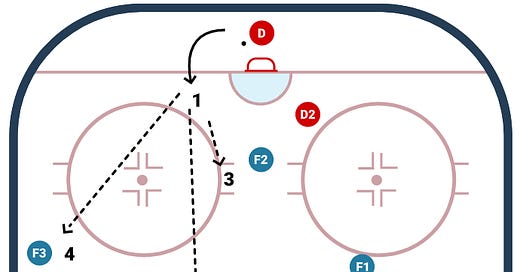Speed and physicality are two traits that make hockey the greatest sport on the planet.
When playing such a fast-paced game, it’s critical to have the quickness of mind to navigate chaotic waters. The reads of where to move and pass the puck next must be quick and crisp. The best players are able to simplify the game is by utilizing progressions.
Passing progressions
In football, quarterbacks are taught to read their options quickly through pre-set progressions that allow them to scan their potential passing targets quickly and efficiently.
Primary option —> Secondary option —> Safety valve
Here is an example of what this could look like:
Option A - The deep game-breaking pass. If not available, go to option B
Option B - Mid-range and middle of the field. If not available, go to option C
Option C - Outside to either left or right side. If not available, go to option D
Option D - Short, known as a “check down”. If not available, go to option E
Option E - Run or throw the ball away in order to live to fight another play
Like in hockey, all of this chaos happens in a matter of seconds. Less experienced/gifted QBs get through fewer reads before running or throwing the ball away (that is, if they aren’t sacked first). Part of what makes the greats so great is that they have the ability to consistently filter through all of their available passing targets.
Having these pre-set reads allows the player to quickly make quality decisions.
Two Elements
1) Coverage read - This is understanding the opposition (defense) and the options (read: reads/looks) that they are giving up. Knowing the opposition and what they are attempting to do allows for a clearer mental picture of the best place to go with the puck.
In essence, players take the coverage read and determine their best progression reads.
2) Progression read - This is understanding your own internal passing progressions and using that information to select the optimum option.
A passing progression is a quick and simple way for players to go quickly through their reads until they find the open player.
Glass and out is not the answer
Understanding reads give your players the tools needed to slow the game down in their heads and is the key to increasing their ability to process situations in games. Put succinctly, when a player’s perception of speed is slowed down, he/she has the ability to make better decisions.
Read More: Processing Speed: Slowing The Perception Of Speed
The middle of the ice is the most valuable real estate on the rink, so getting the puck there should be a priority. In a recent Hockey IQ podcast episode with NHL legend Marty St. Louis, he shared that he coaches his players to read the game from the inside out.
As players grow in their understanding of the game, you would expect to see them go through a progression to read a given situation. A defender breaking the puck out of his zone may have the following progression:
Skate with the puck
Stretch pass long
Pass to the center in the middle
Check down for a short pass to the wall support
Often you’ll see players look only into only one option or space on the ice. A common play in youth hockey is a defender only looking to a winger on the wall on the breakout and never realizing his/her better options.
Coaches should empower their players to go through multiple reads, even though it will backfire at times. Players should take it upon themselves to better understand situations that arise frequently in games and come up with a progression for those scenarios. Adding progressions into a player’s game is a great way to add to their problem-solving toolbox.
Further Reading
Did you enjoy this newsletter?
Help us spread the ideas within and share it with the people you care about




